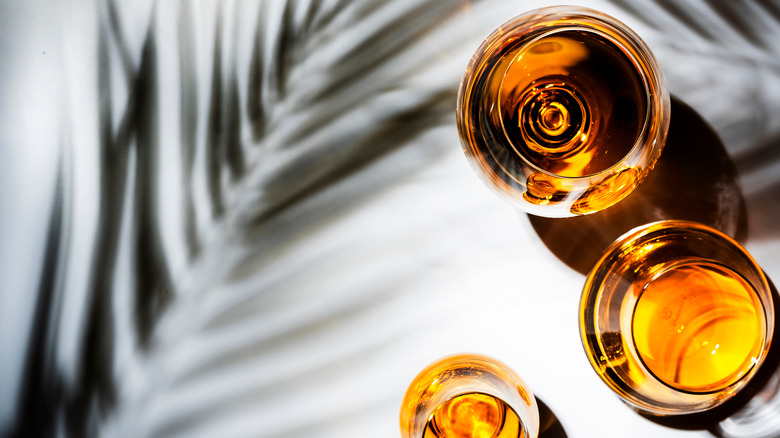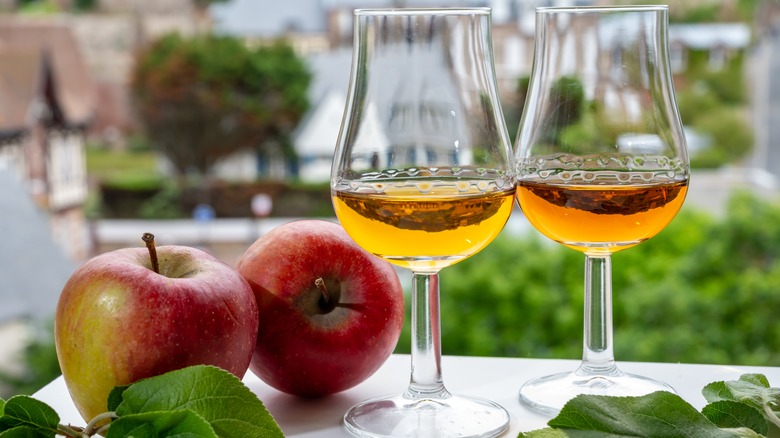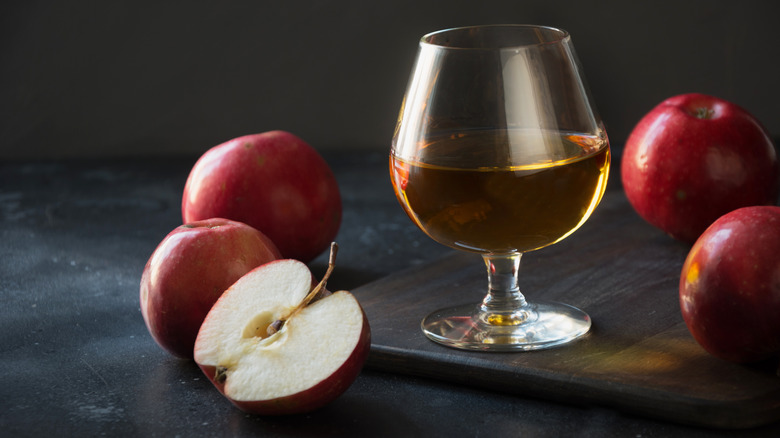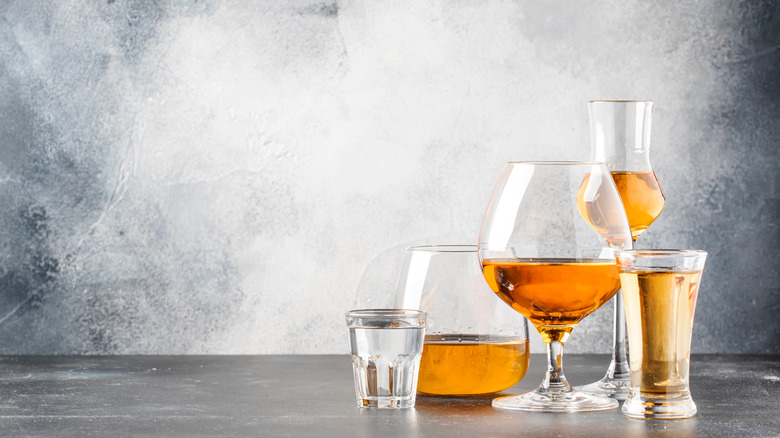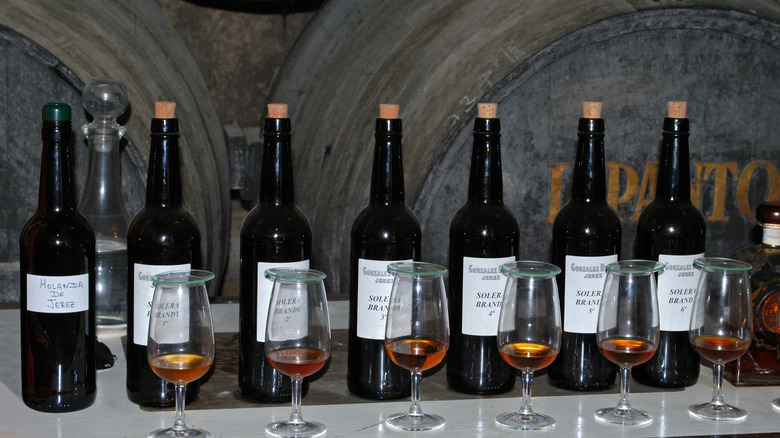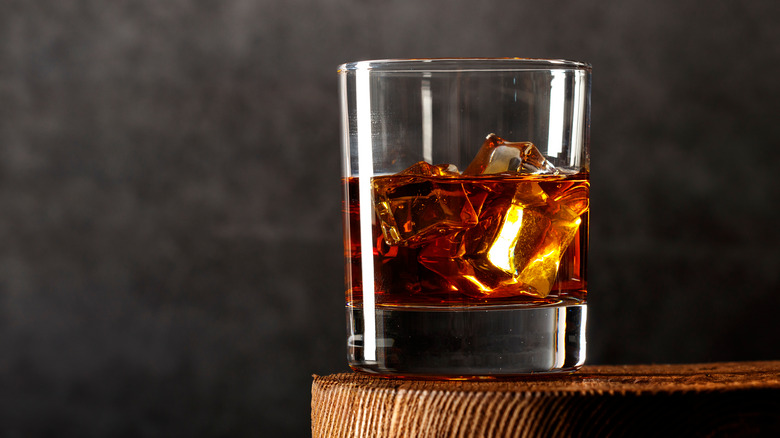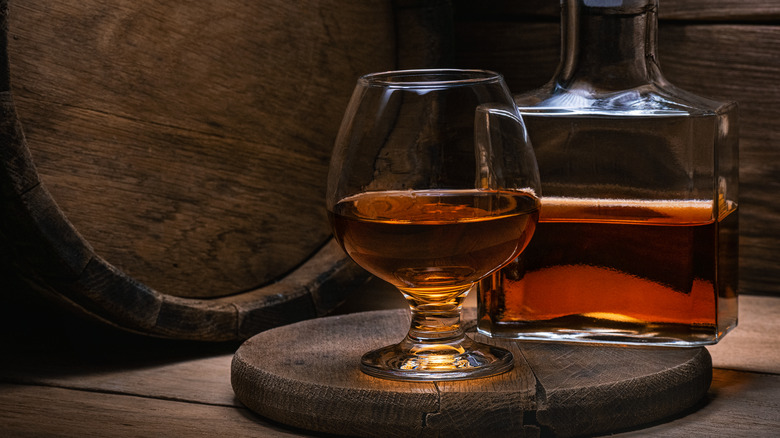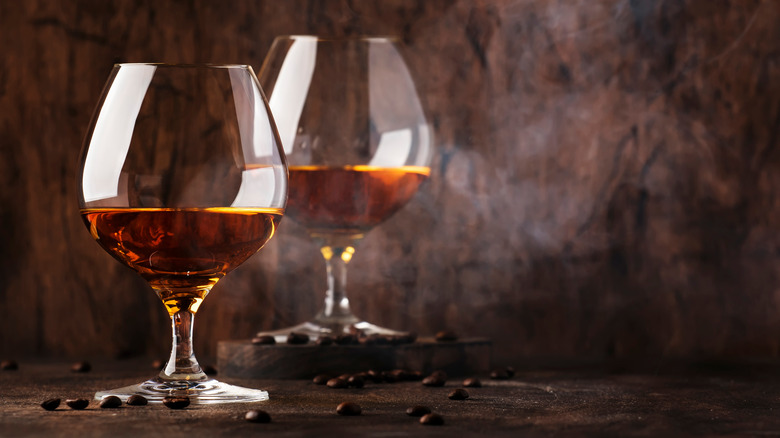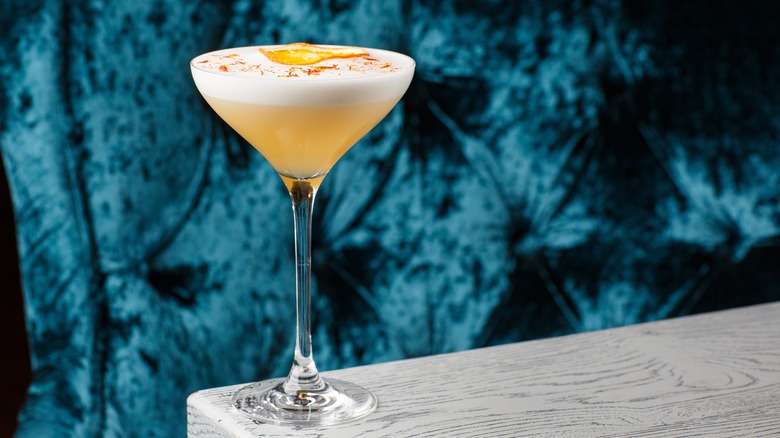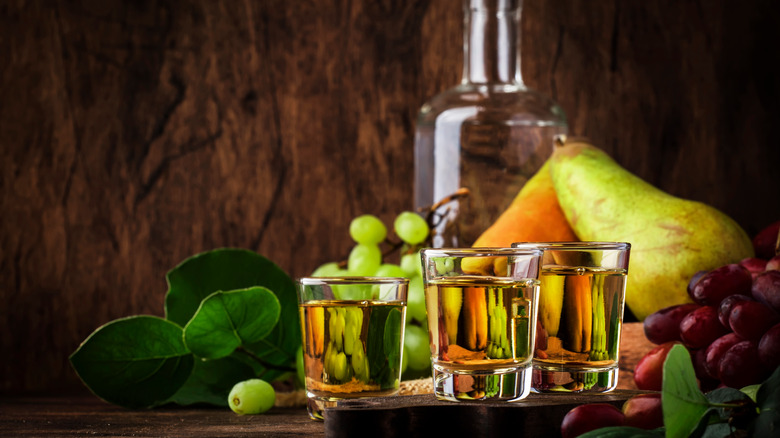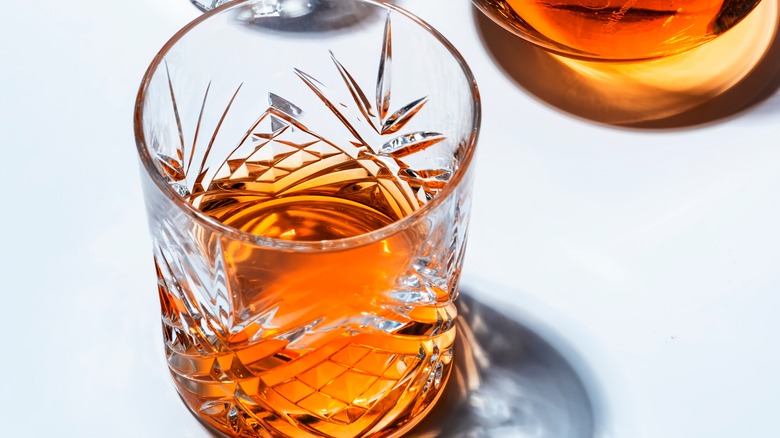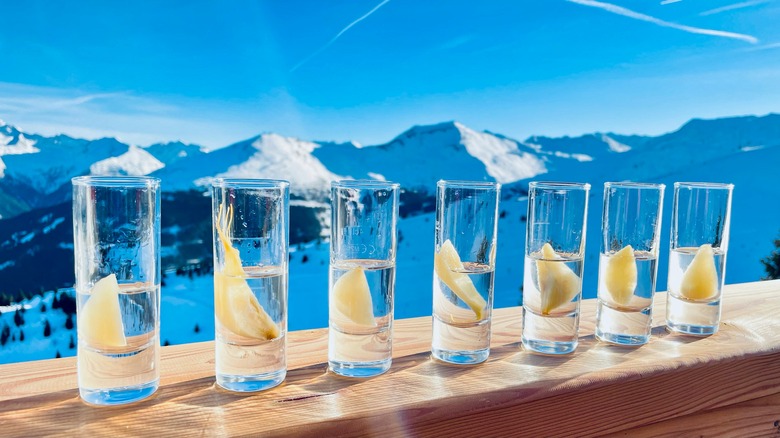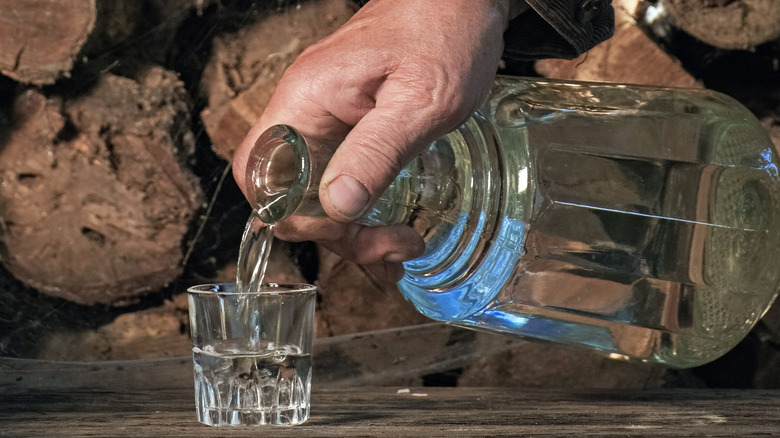12 Types Of Brandy, Explained
Brandy is a favorite spirit of many and is a chameleon that can have a multitude of flavor notes as myriad as the fermented fruits it can be made from. It can elevate everything from your chocolate milk recipes to a carton of brandied cherries. It's also pretty good on its own, imbibed "neat" preferably, and taking centerstage on your palate.
Although brandy's humble origins began with distilled wine made from grapes, it can be made from several different fruits relative to the regions in which it's produced. Variations may incorporate a fruit mash or pomace, which The Chicago Tribune describes as being the residual mash left over following the pressing of fruit into "young, rough, [or] unclarified wine." The pomace is left to ferment for traditionally dictated periods of time. Fortunately, that just means there's a relatively wide selection of brandy to explore.
According to The Ottawa Citizen, once Dutch traders caught on, they began sharing the sweet libation they called brandewijn, or "burned wine," throughout northern Europe — named so after the process of distillation where wine was heated over a fire to remove impurities before being aged in stainless steel vats or oak. The Dutch were responsible for sharing Cognac with the rest of the world. With that said, let's take a look at what the full scope of brandy has to offer and what makes each type so special.
Calvados
Some say an apple a day keeps the doctor away, but we think calvados should be the apple of your eye. Calvados, a regional brandy from Normandy, France, was conceived all the way back in the 1500s. According to Wine Enthusiast, its prominence began in the 1900s as a preferred brandy after a plague of grape-obsessed insects called phylloxera wiped out French vineyards in the mid-1800s. The stowaway bugs rode in on ships carrying vine samples from U.S. vineyards. French winemakers were trying to stay abreast of what their competitors were doing, but as Smithsonian Magazine notes, the move backfired spectacularly.
The pivot from grape-based brandies to other fruits had begun. Calvados starts as apple cider, produced by first pressing and fermenting the apples. According to Business Insider, the cider is distilled and placed in oak casts for at least two years to be considered true calvados by the appellation d'origine contrôlée — the French Ministry of Agriculture and Food Sovereignty's regional designation of authenticity.
Calvados, best enjoyed without ice in a tulip-shaped snifter, has upfront notes of spice and wood with the essence of the regional apples used lingering on the back end. Calvados is traditionally seen as a fabulous post-dinner finisher, but there's nothing stopping you from enjoying it before a meal either.
Applejack
Calvados's American cousin by way of New Jersey is applejack brandy. A story by The New Jersey Digest points to William Laird, a Scottish immigrant, and distiller who settled in Monmouth County, NJ, as America's founding father of applejack brandy. Laird's good use of the abundance of apple orchards in the area allowed his hooch operation to grow into a family dynasty that — thanks to Laird's great-grandson Robert Laird — kept George Washington and his troops warm and fuzzy during the Revolutionary War. America's first president was a fan of Laird family brandy and wrote a whole letter held in the National Archives about what he called the "sweet cyder."
A New York Times article reveals the "jack" in applejack refers to the distillation process colonists used to produce brandy. Jacking didn't involve heating the cider but rather freezing it. Instead of the French method of heating cider until it condensed with higher concentrations of alcohol, American distillers would collect the slushy runoff in a barrel until the alcohol content was high enough.
Like its French forebear, applejack can be great on its own in a glass with no ice. However, we would be remiss not to mention that applejack also makes a great cocktail mixer. Try it with vermouth, yellow chartreuse, grenadine, and lemon juice for a herbaceous twist on a sweeter Jack Rose recipe.
Grappa
Grappa is an Italian wine through and through, and the short form of the original Latin word grappapolis, meaning "bunch of grapes." As you've guessed, it is made from, well, a bunch of grapes. The Italian Tribune describes its flavor as "fragrant and strong" and nods to the ancient Romans as creating the distillation method that turns pomace — the bits of grapes leftover from winemaking — into grappa, then considered a working-class version of wine.
According to Upscale Living Magazine, like calvados in Normandy, grappa has an official product designation (PDO) stating true grappa can only be made in Italy. The Romans used it to make plonk, while Benedictine Monks treasured it for its medicinal properties as a digestif. Today, the distillation process still involves fermented pomace, just on a larger scale. Difford's Guide notes that the pomace is typically stored in massive silos or refrigerated to keep its moisture and protect it from oxidation, then after separating the odd bits from the liquid, distilled in steam boilers, rested in large vats for six months, then aged in oak, acacia, ash, or cherry wood casks for at least a year.
A traditional aperitif, this would more than likely be an after-dinner drink of choice, but in more recent times has become the center of attention in cocktails. Try your hand at making a "Basano Mule," a Moscow Mule that replaces vodka with the sweet liquor in a "one, two, three" punch of ginger beer, lime juice, and grappa.
Brandy De Jerez
Jerez is a Spanish city in Andalusia, Spain, and the birthplace of Brandy de la Jerez, also known as sherry brandy. From the early 8th to 15 century, the Moors ruled large swaths of Andalusia and, according to Forbes, brought knowledge of distillation to the Spanish in the 8th century, making them potentially the first country to produce brandy. The jury's still out on that, but no one can question the popularity of the brandy. Forbes notes some 30 producers — all located within what's known as "the sherry triangle," where all official Brandy de Jerez must be made — make around 80 million bottles a year.
According to the government of Spain's official site for Brandy de Jerez, it's made from either Airén or Palomino grapes, regional grapes that are distilled in column or copper pot stills under intense heat. From these grapes, producers can create three types of brandy de Jerez labeled according to the amount of time the distilled brandy has been aged in oak sherry casks.
Although Brandy de Jerez can be described as intense, Spain's official site for Brandy de Jerez information advises imbibing it in a tumbler glass on the rocks or chilled in a shot glass to dilute the intensity. The tried and true way of leveraging the strong character of any liquor into a more manageable but interesting cocktail always works too. This Don't Shenaut cocktail recipe is one you "don't" want to avoid.
Cypriot Brandy
Cypriot brandy is a brandy specific to Cyprus, and like all of the brandies on this list, it has a unique history. Cyprus is an independent island state situated between Greece to the east and Turkey to the north, and according to Brittanica, it has a large Greek and Turkish community that heavily influences island culture.
The distillation process mimics the traditional method, requiring fermentation of regional fruits — in this case, white xynisteri grapes that give the brandy a "warm raisin" flavor, according to Cyprus-based hotel Annabelle. The liquid is heated below the boiling point of H2O while staying above the boiling point of alcohol. This ensures the producer extracts all the unique essence of the grapes without wrecking your buzz.
If toasty raisins are your thing, a tippler of Cypriot brandy may be all you need to end your day. Also, consider adding Cypriot brandy to lemon, soda water, and angostura bitters to create Cyprus' national drink — the brandy sour. As told by Visit Cyprus, the 1950s origin of the drink comes from an old hotel in the Troodos Mountains, which served it to the visiting ruler of Egypt and Sudan, King Farouk. The king, who was Muslim, liked alcohol but couldn't be seen to be enjoying it. So, the hotel mixed him a brandy cocktail that looked like iced tea.
We're not suggesting you try anything like that, but it might help make that unending virtual meeting a little more bearable without tipping off your boss.
Cognac
The most prestigious brandy on this list is Cognac, named after the town of Cognac in France. According to Brittanica, there are very specific French laws around what grape variety is grown and used in the distillation process (ugni blanc grapes), how it's distilled (twice in special pot stills), how long and where it's aged (in Limousin oak for at least two years), and where the whole thing takes place (Charente and Charente-Maritime) in order to be considered Cognac. So while every Cognac can be considered a brandy, Cognac as a type of brandy can only come from Cognac, France.
International distiller Hennessy follows the traditional Cognac production season (October 1st to March 31st each year) and has enlisted an expert tasting committee for the last 200 years to ensure the quality of every batch. Basic 2-year-old Cognac is considered V.S. (very special) according to Town and Country, 4-year-old Cognac is V.S.O.P (very special old pale), and X.O. (extra old). The classifications hint at the quality.
Strong but smooth, we think Cognac is a brandy deserving of taking the spotlight in a snifter glass with no ice. Of course, There's nothing wrong with a good Sidecar cocktail, or if you're up for something new, mix yourself a Between the Sheets recipe for a more citrusy kick.
Armagnac
According to Armagnac Magazine, Armagnac's 700-year history can be traced back to 1310, when it received an earnest mention in religious scholar Vital Du Four's book documenting great discoveries (via BBC). According to Forbes, it comes from the Armagnac region of Gascony province and has its younger cousin, Cognac, beaten by about 200 years. As the LA Times stories, Armagnac isn't held to strict standards when it comes to grape selection, allowing for several grape varietals.
The distillation process is similar to the other French brandies in this list but only goes through a single distillation versus Cognac, which goes through two, and the wooden casks it's aged in are oak wood in Gascony Province. In France, much like real estate anywhere, it appears to be all about location, location, location.
Brandy importer Charles Neal is quoted in Wine Enthusiast as saying the difference in flavor and texture between Armagnac is, "Cognac is almost like the vodka that you store on the kitchen counter, whereas Armagnac, texturally, is more like the vodka in the freezer, thicker and richer on the palate." Where Cognac can be understated, Armagnac can be a little more in your face. If in your face is what you're into, nothing is stopping you from enjoying it on its lonesome or in a killer Armagnac Sidecar.
Pisco
Business Wire begins the story of pisco — which means "bird" in Quechua, an Indigenous language of South American Indians — in 1553 after the Spanish arrived in Peru with grape vines from the Canary Islands to make themselves wine. According to SFGate, Peruvian pisco is made from eight grape varietals from five coastal regions with 500 producers in 42 valleys. Unlike the French brandies, Forbes explains that pisco goes through a single distillation in massive copper pot stills called alambique and is stored for a minimum of three months before it's ready for bottling.
Now's probably a good time to talk about the other pisco capital, Chile. According to Culture Trip, Chileans claim to be the originators of pisco based on a border dispute between the two countries going all the way back to the 1500s and believe an Indigenous Chilean civilization called the Aymaras were first to the pisco game. Whatever the case, Chilean and Peruvian pisco production differ in a few ways. Chilean pisco doesn't adhere to single distillation, which means a more potent alcohol content. It can be aged in everything from glass containers to wood casks and ceramics. Every distillery is also expected to use grapes grown in their vineyards, meaning different grape varietals like muscat, torontel, or Pedro Ximénez are used. We don't have to engage in friendly rivalries over who made what first. We just make pisco sours.
Rakia
The national drink of Balkan nations like Bulgaria and Serbia is a brandy that can be made with practically any fruit, according to Culture Trip. Plums, apricots, grapes, and for a little extra something, even honey, herbs, or nuts could be involved in the distillation process. Rakia stems from the Arab word araq, which was another distilled drink in the Middle East that may harken back to The Ottoman empire's influence in the Balkans while under their rule from, according to the BBC, the 14th century until 1912.
According to Delishably, most rakia in the Balkans is homemade and fermented in wooden barrels for up to a month before being distilled in a large outdoor cooking apparatus called a kazani, which is a giant kettle of sorts. Unlike many other brandies on this list, rakia is ready to drink in three hours, not three months or years. Of course, when your brandy is homemade and can include any number of fruits and additional elements to its production, what every rakia tastes like is really based on who the distiller is. Still, the general consensus is that it should be pretty strong since it's basically the moonshine brandy of the Balkans.
Kanyak
If you're thinking kanyak is suspiciously similar to Cognac, you would be half right. Kanyak, the Armenian Cognac according to The Daily Beast, is derived from regional grapes (Voskehat, Garan Dmak, Mskhali, Kangun, and Rkatsitelithat) that have been fermented into white wine, distilled in large stills, and left in oak casts for up to a decade before being imbibed. The relationship to French Cognac apparently goes back to 1825 when Armenia — under Russian rule at the time — had its first taste of Hennessy imported from France.
The first Armenian brandy distillers, Nerses Tairan and Vasily Tairov took what they learned working with French winemakers in France into their business in 1877, setting the stage for Russian businessman Nikolay Shustov to make it big with his own Armenian brandy Shustov & Sons. Shustov and Sons grew to be the largest producer of Armenian brandy in the world (the Yerevan Brandy Company), and according to Forbes, has the most brandy distilleries in the world, including Cognac, France.
Obstler
You've probably never heard of obstler brandy, but you've likely heard of schnapps. Well, it may blow your mind to learn this, but according to Tourist Secrets, schnapps is the Austrian version of fruit-based brandy. Obstler brandy stems from the German obst, meaning "fruit", and there are as many variations of schnapps as there are fruits used to produce them.
Obstwasser (fruit water) combines apples and pears, zwetschgenwasser (plum water) uses plums, poire Williams (William's pear) extracts pears, kirschwasser (cherry water) the essence of cherries, and finally, marillenschnaps (apricot brandy) which builds off of apricot.
Once it has gone through the distillation process, according to National Geographic, the liquid is clear, strong, and fruity, with about 40% alcohol content. Although Austrians prefer to taste them on their own, brandy, a.k.a. schnapps, makes great foundations for cocktails like vodka martinis, Manhattans, and fuzzy navels, or they also make for a worthwhile Sex on the Beach recipe.
L'eau de Vie
According to Scientific American, the history of brandy liquor started in France as a medicinal elixir derived from fermented grapes. It was so respected by French physicians of that period it was called l'eau de vie, meaning "the water of life." Scientific American goes on to explain that back in the early days, before alcohol content could be determined through scientific means, the way to determine ABV in eau-de-vie was to pour some out over a little gunpowder and light it on fire. The concept of "proof" stems from this practice where if the gunpowder remained on fire after the liquid burned away, the brandy was considered "above proof," or, as we now say, overproof.
However, according to Difford's Guide, eau-de-vie is a term used in France to describe brandies made from fruits other than grapes. You could say every eau-de-vie is a brandy, but not every brandy is an eau-de-vie. Mashed fruits are fermented with yeast, and the wine produced from that fermentation is distilled by high heat. Once the aging process is complete, according to France Today, the eau-de-vie is diluted by pure spring water before being refrigerated and filtered before being bottled. If this list of brandies has piqued your interest, check out this great list of the best brandy bottles around.
